Vitreous Support: Floaters
Symptoms Causes Related conditions
It is possible to provide support for a healthy vitreous humour with a combination of dietary considerations and supplements. The traditional Chinese medicine model of vision health holds that the liver meridian supports overall eye health and especially the health of the vitreous. One such formula is called "Xiao Yao San" or "Rambling Powder," on which our Revision Formula is based. Milk thistle extract may also help reduce floaters.
Floaters are basically debris floating around in the vitreous gel. The body is slowly trying to break them down. The natural way to help this process along is to stimulate the flow of energy through the eyes. This occurs slowly because there is no blood flow in the vitreous, but the body does create phagocyte cells (part of the immune system) in the vitreous that have the potential of breaking down eye floaters over time. The revision formula may speed this along.
Vitamins
& Supplements
Not sure which to get?For help call us at 845.475.4158
Complete Product List
On a tight budget?
We recommend
ReVision Formula (wild-crafted herbal formula) 2 oz
Discount Packages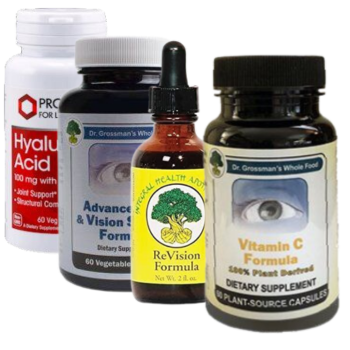 Vitreous Support Package 1 Vitreous Support Package 1Vitreous Support Discount Package Advanced Eye & Vision Support Formula + Hyaluronic Acid + Revision Formula + Vitamin C 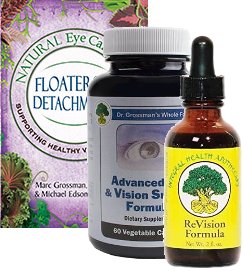 Natural Eye Care Series: Floaters and Detachments/Nutrient Combo Natural Eye Care Series: Floaters and Detachments/Nutrient ComboBook and nutrients to support eye floater management and prevention. |
Essential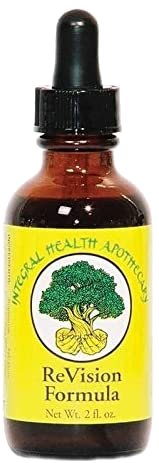 ReVision Formula (wild-crafted herbal formula) 2 oz ReVision Formula (wild-crafted herbal formula) 2 ozThis wild-crafted herbal formula is based on a classic Liver patent formula used in Chinese medicine for overall eye and body health. |
Essential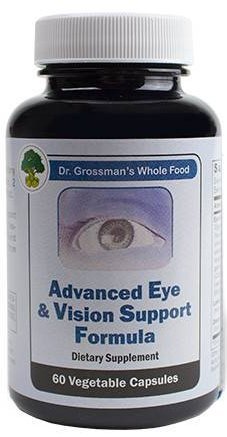 Advanced Eye & Vision Support Formula (whole food) 60 vcaps Advanced Eye & Vision Support Formula (whole food) 60 vcapsWhole food, wild crafted herbal vegetarian formula with vision antioxidants, chemical- and preservative-free. |
Essential Hyaluronic Acid (vegetarian) 100 mg 60 vcaps (P3155) Hyaluronic Acid (vegetarian) 100 mg 60 vcaps (P3155)Vitreous & joint support vegetarian/vegan formula. This formula is on. The replacement is Hyaluronic Acid 70mg 60caps. |
Very Important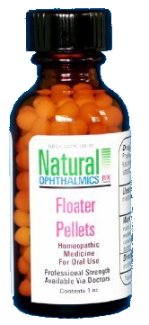 Floater Homeopathic Pellets - 2 month supply Floater Homeopathic Pellets - 2 month supplyHelps body try to dissolve eye floaters. |
| Very Important 8 sources of Vitamin C plus Bioflavonoids |
Very Important Hyaluronic Acid (vegetarian) 100 mg 60 vcaps (P3155) Hyaluronic Acid (vegetarian) 100 mg 60 vcaps (P3155)Vitreous & joint support vegetarian/vegan formula. This formula is on. The replacement is Hyaluronic Acid 70mg 60caps. |
| Important Milk Thistle Seed 2 oz |
Conventional Treatment
There are no conventional treatments; patients are usually told they must learn to live with them.
Vitrectomy. In more serious eye floater conditions, a vitrectomy surgery may be recommended, although there is the risk of side effects.
Laser Surgery. Laser surgery is generally not very effective but is lower risk. A few doctors perform laser surgery for floaters, but it depends upon where the floaters are located, the quality of the vitreous gel and the type of floater. Most patients who may be candidates for laser surgery have experienced PVD (post vitreous detachment), which can push floaters toward the center of the eyes and away from the lens and retina. However this practice is still considered outside the scope of conventional ophthalmology practice.
Complementary Treatment
Maintaining a healthy diet can help prevent the onset of floaters, particularly with foods that contain vitamin C, silica, glucosamine sulfate, MSM, omega-3 fatty acids, and other nutrients listed below to help maintain the integrity of the retina, vitreous, and connective tissue.
Diet, exercise, and targeted supplementation can go a long way in strengthening the retina and supporting the vitreous. Research has determined that the body supplies certain nutrients in the eye such as hyaluronic acid that helps support the vitreous and connective tissue.1
Diet & Lifestyle Recommendations
- Eye health support recommendations for supporting healthy vision.
- Diet Add fresh juiced vegetables and fruits to your diet, best if organic. Our recipe for vitreous support includes some combination of these foods: garlic, beets, parsley, carrots, celery, apple, parsnip, raspberries (just a little fruit). Also see more information on juicing.
Recommended Nutrients
These are the nutrients that are most important in managing eye floaters. In general, by strengthening the health of the retina and vitreous, one reduces the risk of developing new floaters. These nutrients act together synergistically to help lessen the risk of floaters.
- Vitamin C. Vitamin C is a powerful antioxidant that is essential for overall eye health. Since floaters are often the result of vitreous tears/detachments and/or clumping of the vitreous due to aging, vitamin C plays a role in blood and lymph circulation, waste elimination and supporting connective tissue. Vitamin C is found in high concentrations in the eyes and helps neutralize the effect of oxygenation in the ocular fluids.2,3,4
- Hyaluronic acid. Hyaluronic acid (hyaluronan) is a large molecule found in the vitreous gel which it is believed contributes to its gel-like quality5 and may also support related connective tissue in the retina.6 Elsewhere in the body it is found in the gel-like fluid that lubricates joints and it is a component of the tissue healing process. As we age, the amount of hyaluronan in the body decreases.
- Liver Tonic. We recommend the classic Chinese liver formula xiao yao san, which contains rehmannia, milk thistle and dandelion. In Chinese medicine, the Liver “opens to the eyes” and stimulates energy and blood circulation throughout the eyes and body.
Also may be helpful
- Antioxidants, including lutein and zeaxanthin, both of which are essential nutrients for keeping the retina healthy.
- Omege-3 fatty acid, which generally helps reduce the incidence and progression of retinal conditions.
- Homeopathic floater pellets
Footnotes
1. Stolyszewski, I., Niemcunowicz-Janica, A., Pepinski, W., Spolnicka, M. Zbiec, R., et al. (2007). Vitreous humour as a potential DNA source for postmortem human identification, Fola Histochem Cytobiol, 45(2):135-6.
2. Pirie, A. (1965). A light-catalysed reaction in the aqueous humor of the eye. Nature, 205:500–501.
3. Takano, S., Ishiwata, S., Nakazawa, M., Mizugaki, M., Tamai, M. (1997). Determination of ascorbic acid in human vitreous humor by high-performance liquid chromatography with UV detection. Curr Eye Res, 16(6):589–594.
4. Eaton, J.W. (1991). Is the lens canned? Free Radic Biol Med, 11(2):207–213.
5. Brewton, R.G., Mayne, R. (1992). Mammalian vitreous humor contains networks of hyaluronan molecules: electron microscopic analysis using the hyaluronan-binding region (G1) of aggrecan and link protein. Exp Cell Res, Feb;198(2):237-49.
6. Jumper, J.M., Chang, D.F., Hoyt, C.S., Hall, J.L., Stern, R., et al. (1997). Aqueous hyaluronic acid concentration: comparison in pediatric and adult patients. Curr Eye Res, Oct;16(10):1069-71.
 info@naturaleyecare.com
info@naturaleyecare.com



 Home
Home



 Vision
Vision Vision
Vision



 Health
Health Health
Health Research/Services
Research/Services Pets
Pets About/Contact
About/Contact


